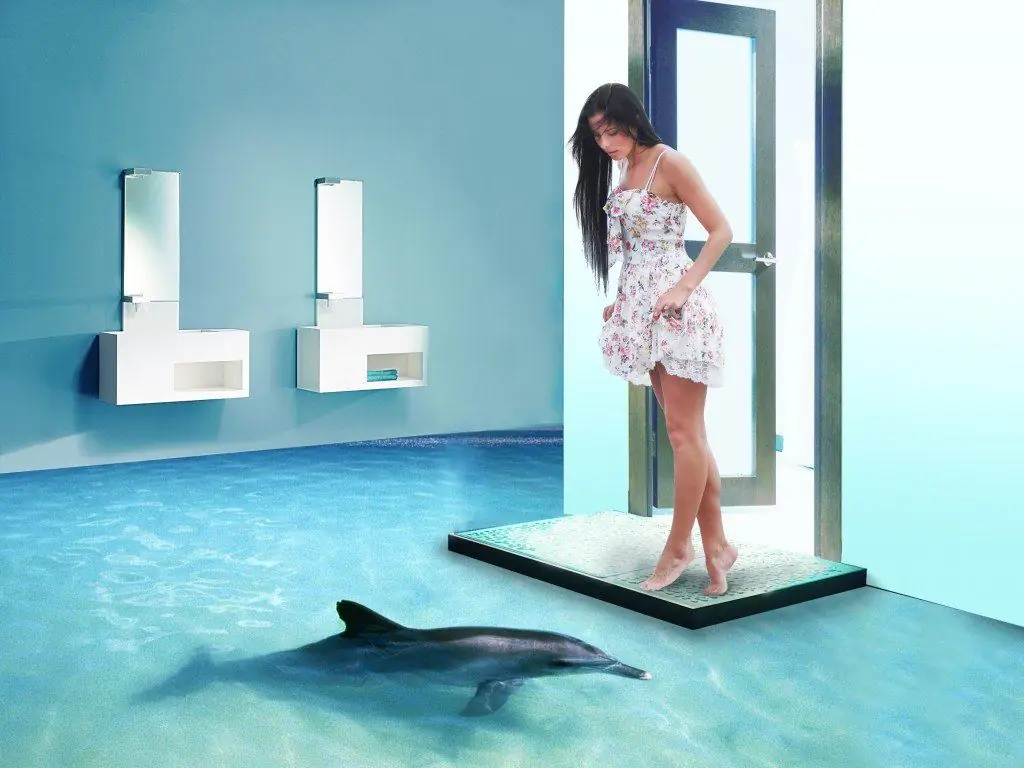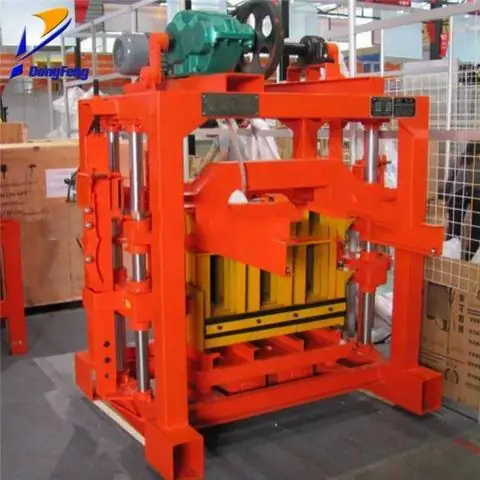
Table of contents:
- DIY 3D self-leveling floor: for those who are not afraid of new solutions
- Advantages of 3D floors and their features
- How to make a DIY 3D self-leveling floor
- We prepare the surface for the self-leveling floor
- Polymer leveling layer: how to apply correctly
- Drawing on the surface
- Fill in the transparent polymer component
- Video about pouring decorative 3D floor with your own hands
- Author Bailey Albertson [email protected].
- Public 2023-12-17 12:53.
- Last modified 2025-01-23 12:41.
DIY 3D self-leveling floor: for those who are not afraid of new solutions

As you know, a properly made floor is the basis for a good renovation. In addition, we all want to bring something new and unusual to the interior of our home, including the surface of the floor. Modern building materials and new technologies will help you make a floor that will not only be reliable and functional, but also attractive, complementary or defining the style of the interior. In this article, you will learn what 3D floors are and how to make them right.
Content
- 1 Advantages of 3D floors and their features
- 2 How to make a DIY 3D self-leveling floor
- 3 We prepare the surface for the self-leveling floor
- 4 Leveling polymer layer: how to apply correctly
- 5 Draw a drawing on the surface
- 6 Fill in the transparent polymer component
- 7 Video about pouring decorative 3D floor with your own hands
Advantages of 3D floors and their features
The technology for installing 3D floors compares favorably with its efficiency and the possibility of using it both in a residential and office or commercial space. The features of 3D floors include:
- originality and attractive appearance;
- a large number of design solutions;
- wear resistance and long service life;
- resistance to mechanical, chemical damage, moisture;
- hygiene;
- mounting on any type of base.
In any room, self-leveling decorative floors with their own hands can become an unusual addition to the interior. For example, in a nursery, these may be images of characters from your favorite cartoons; in the bedroom there is a famous painting or ornament, and in the living room there is a flower meadow.

Also, reviews of self-leveling floors with their own hands speak of the ease of caring for such a coating. A continuous, dense layer that is not prone to cracking or gaps, repels dust and greatly simplifies cleaning. Such a floor can easily withstand any mechanical stress, whether it is the installation of massive furniture or the fall of a heavy thing. Manufacturers give a guarantee for self-leveling 3D floors for about 40 years without changing the structure and color. Even if you manage to damage the self-leveling floor, you can easily repair it. To do this, it is enough to replace the damaged area, and not the entire coating completely.
How to make a DIY 3D self-leveling floor
Installation of such a floor is carried out in stages as follows:
- we prepare the surface;
- apply a base leveling polymer layer;
- glue the image;
- fill in the transparent polymer component;
- we apply a final wear-resistant shockproof layer.

- Not only drawing and photography can serve as a background for your DIY 3D floor. You can get creative and use natural or decorative materials such as sand, pebbles, stones, dried leaves and flowers. The ability to experiment is one of the main distinguishing features of 3D self-leveling floors.
- It is usually recommended to contact a specialist professionally engaged in the manufacture of decorative self-leveling floors using 3D technology. If you are confident in your abilities, then you need attention and accuracy, since the manufacture of a three-dimensional coating requires precise adherence to technology.
- A decorative three-dimensional coating is similar to a self-leveling self-leveling floor, but it has certain features, such as surface preparation. Since the polymers used for the filling are quite toxic, you will need to arrange additional ventilation in the room - a respirator will not help.
- It is very important to maintain the temperature regime. The room where the work will be carried out must be at least 10 degrees.
We prepare the surface for the self-leveling floor
- The first step is to properly prepare the base for our decorative 3D floor. To do this, remove the doors in the room, baseboards and remove the old floor covering. If your apartment has high humidity, a waterproofing layer will be required.
- Next step: screed concrete on the waterproofing layer, or level the surface with a cement-sand mortar.
- After the surface is completely dry, grind it with a grinder or grinder with a diamond disc with a diameter of 18 cm. Place areas with large projections with a puncher, and fill cracks, gouges, chips with mortar or epoxy resin.
- Carefully remove a smooth concrete surface from dust and debris. Remove oil stains, if any, otherwise the 3D self-leveling floor will not adhere to the base at this point.
- Be sure to prime the prepared substrate so that even the smallest pores and cracks are filled. To do this, use spatulas, flat brushes or short-haired rollers. The primer must be applied in two layers.

Polymer leveling layer: how to apply correctly
At least 4 hours after the prepared surface has been primed, but not more than a day later, a polymer leveling layer can be applied, which is optimally suited for drawing on it. Carefully consider the choice of shade, since such a floor will be the base and will determine the background, especially if you plan to use natural materials for decoration.

A special polymer compound is applied over the screed. Mix the clear polymeric finishing floor and special solvent at a ratio of 2: 1. Manual mixing is not suitable in this case, so use a special mixer. Prepare the polymer mixture in small portions, exactly as much as you use at a time, because after half an hour it begins to harden. Pour the compound onto the floor surface while leveling using a rule. You will also need a special needle roller, with which air bubbles are removed from the base. Wait for polymerization, it will take at least a day. Check the evenness of the surface with a level. In order for the base to dry completely, you will need about seven days, so do not wait for the final polymerization if you decide to decorate the floor with shells,pebbles and other small items. After the base is completely ready, proceed with the surface decoration.
Drawing on the surface
In order to create an image for self-leveling decorative floors with your own hands, they usually use two methods:
- drawing with acrylic or polymer paints;
- pasting the finished drawing.
The first method is considered the most reliable, but at the same time, it is quite expensive. Firstly, special paints designed to create stable images on such surfaces are not cheap. Second, the work of an artist can be the biggest expense. Even if you are an artist and plan to paint your floor yourself, it will take a long time.
If you are using paints for drawing, you will need a layer of special varnish to protect the image from other manipulations. Pasting the finished drawing is the most common way. Select a picture that you like, process it in a graphic editor and print it on a suitable medium in the desired size.
The easiest way is to order a printout at a printing house in a resolution of 1440 dpi on matte satin. It is the printout of the picture that will be the biggest expense if you decide to use this technology.
Apply the self-adhesive image to the base carefully, smoothing it carefully to avoid air bubbles. If you are using a thermal print on banner fabric, slightly dampen the surface before applying the design. Just as in the first case, watch out for air bubbles.

A photo of a self-leveling floor with your own hands will help you choose the most suitable from the range of coatings.
Fill in the transparent polymer component
- Calculate the volume of the polymer layer you will need for the job. In this case, keep in mind that the thickness of the composition layer over the image must be at least 3 mm. In this case, the calculation will be approximately 3-4 kg of substance per 1 sq. M. surface.
- Take a clean dish of a suitable size and mix in it all the floor components in the required amount. For mixing, use a drill with a special attachment.
- Pour the resulting clear solution in portions onto the floor and level with a rule. Also use a needle roller, rolling it until the floor begins to thicken. This usually takes 15 to 40 minutes.
- If you need to move on a flooded surface, use special shoes with spikes - paint shoes. Also cover the self-leveling floor with foil or plastic wrap to increase its strength.
- Depending on the thickness of the layer and the temperature in the room, the DIY 3D self-leveling floor will dry out from 7 days to 3 weeks.
So, the floor is almost ready, and all that remains is to provide it with additional protection from chemical and mechanical damage. A special protective varnish will help with this.

There is a very large selection of such materials on the modern construction market, both shockproof and anti-slip. In addition, having treated the floor with such a varnish, you can take care of the surface using any detergents and cleaning agents.
Video about pouring decorative 3D floor with your own hands
As you can see, the independent production of a self-leveling 3D floor is not a difficult task, but it only requires great care and adherence to technologies, as well as the use of high quality materials. Plus, you can save a lot of money. If you have any questions or suggestions on the topic of this article, please post them in the comments. We will also be glad if you share your experience in such work. Good luck and comfort to your home!
Recommended:
What Means And How To Dry-clean The Car Interior With Your Own Hands + Photos, Videos And Reviews

You can do it yourself dry cleaning of the car interior. You just need to know which means are suitable for this
A Step-by-step Guide To Erecting A Floor In A Bathhouse (including With A Drain) With Your Own Hands With Photos, Videos And Drawings

Do-it-yourself flooring requirements and technologies in various rooms of the bath. Step by step guide. Photo and video
How To Make A Clothes Dryer With Your Own Hands Or Choose, Assemble And Install A Ready-made (ceiling, Floor, Liana Or Other), Other Tips

Dryers for clothes: floor, ceiling, wall - how they differ. How to choose the right one or assemble it yourself, including from scrap materials
We Repair A Coffee Grinder With Our Own Hands: How To Disassemble, Wash And Adjust, How To Grind Coffee Correctly + Video Instructions

What coffee grinders are, how to grind coffee correctly, what are the malfunctions, how to repair a coffee grinder with your own hands
We Decorate The House For The New Year With Our Own Hands: A Selection Of Ideas And Photos Of Decor

How to decorate a house for the New Year. DIY garlands, compositions, snowflakes and toys for the Christmas tree. Decorations for windows. New Year's table setting. Photo galleries
